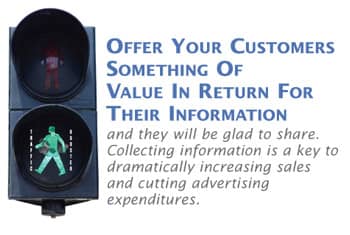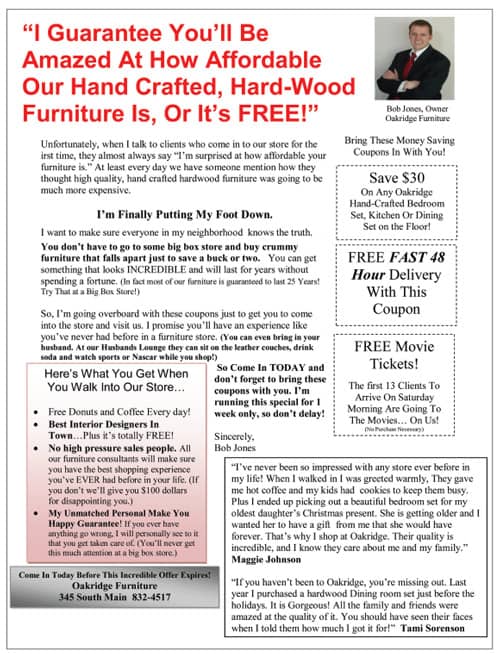Part 1: Here’s how direct response marketing techniques can achieve specific, traceable and cost effective results.
Advertising Strategy by Brett Kitchen and Ethan Kap
Steve is a furniture retailer who recently suffered a big drop in business. His traffic and sales are declining just like many other independents in our industry. Part of the problem is the decreased effectiveness of his newspaper, radio and television advertising.
There are many reasons for lower advertising effectiveness. These include TIVO, satellite radio, the emergence of the internet as a powerful source of news, cynical consumers who don’t believe in “another 40% off sale,” and busier, more time conscious consumers.

Steve does item advertising, sale advertising and works hard with his ad manager to brand his store’s image. If your store is anything like Steve’s, you may wonder if there is anything you can do to get your traffic numbers back to where they belong? You Bet There Is. That’s if you are willing to accept a new way of marketing.
Here’s the deal: A store owner’s most important responsibility is to attract customers and keep them coming back. Sounds simple enough right?
Unfortunately it’s easy to spend hours and hours working on projects and putting out fires that have nothing to do with attracting, converting and retaining customers.
Bad advice about advertising abounds. That’s one reason why we see the “same old, same old” home furnishings ads in newspapers, radio and TV. Competitors in marketplaces all over the country use similar ads. It is an example of the “blind leading the blind.”
I talked to a store owner at the Las Vegas Market. He said “I’m spending a fortune on advertising, but I don’t dare stop anything because I don’t know what’s working and what’s not.” This is the way most retailers feel. They’re unable to track their advertising results individually by campaign because of the type of advertising they are doing. It’s impossible to run effective advertising without tracking results and fine tuning the marketing.
You can solve all these problems by using the direct response marketing techniques presented in this six part series of articles in FURNITURE WORLD Magazine.
Direct response is the opposite of brand building. It is designed to elicit a response from your customer or client immediately. And it is traceable down to the penny. You’ll never be in the dark again when it comes to what’s working and what’s not.
‘Image’ or ‘Brand’ building is what large companies do. Many in the advertising world want you to believe that you have to build a media “brand or image” to be successful. Image advertising works if you have a very large advertising budget. We’re talking about companies like Nike, Coke, Ethan Allen and La-Z-Boy. These companies have the means to develop sophisticated branding themes, prepare slick commercials and then flood the airwaves with consistent branding messages. Moderate size retailers in most markets end up running a course of pre-packaged “me-too” ads and find that they are unable to measure their effect (measured in sales).
DIRECT RESPONSE MARKETING ALTERNATIVE
Direct response marketing is designed to get specific, traceable results. If done correctly, a direct response ad will more than pay its own way. It’s purpose is to inspire a prospect to get off the couch, call you, or come into your store and buy. Why else would you be advertising? You advertise to get sales. Period.
In 1987 Nordic Track was only a 20 million dollar a year company, using traditional image advertising. After switching to Direct Response Marketing strategies, they quantum-leaped to become a $250 Million a year company! Nordic Track did this by following the direct response marketing formula.
Four Step Formula To Effective Direct Response Marketing
#1. Create a Unique Selling Proposition: The Unique Selling Proposition or USP is summed up by the phrase, “Why would your customer do business with you, above, any and all other options, regardless of price?” You must answer this question in your advertising! This can be VERY difficult, and we’ll deal with this in much more detail in the February/March issue.
#2.Write effective, relationship building marketing ad copy: Writing ad copy that captures your prospects interest and then builds a relationship to the point where they can trust you is vital. Using the typical “Labor Day Weekend Sale” or your company name as a headline isn’t effective. You must use “Why People Buy” techniques.
Here are a few quick pointers about ad copy.
Your company name is not a headline. It is also not a reason “why people buy”. Headlines are compelling, attention grabbing phrases typically 7-15 words long. An example of a good, strong headline is, “7 Secrets Everyone Must Know Before buying their next bedroom set!” If you were about to buy a bedroom set, would that get your attention? I think so.
Secondly, Your copy must have a "personality". This is the key to creating an emotional bond between you and your customers, and will make them feel obligated to buy from you and you alone.
People want to do business with people. Here are 2 easy ways to put more personality into your advertising.
•Be yourself. Put your own picture on the ads, you can use a picture of you doing something you enjoy like fishing or traveling. You can put a picture of your family or your dog. Use your own voice on TV and radio commercials, and even on the "on hold" messages at your store. When you fashion your advertising messages, make sure that they take the form of a personal message from you to the person you are trying to reach. Even include your signature at the bottom.
•You want to speak as though you are talking to a friend. Imagine what you would say about this piece of furniture if you were presenting it to someone you care about. Your tone needs to be conversational, not institutional. This is the opposite of what most ads sound like. Take a look at some of the advertising that comes across your desk. Does it sound like it came from an interesting, real, live, human being who has friends and a family? Is it boring "me too" ad copy where the narrator refers to him or herself in the third person?
Finally, remember that “The More You Tell The More You Sell.” There’s a reason why people trying to sell stuff don’t just send a picture and a phone number and expect to sell out. WORDS not pictures alone sell. Pictures can be important when used correctly, but never feel bad about having too many words in your ads. If people are interested, they’ll read it.
Create a compelling offer that your prospect can’t refuse: This can include important information like consumer advisories, or free reports; you can give away premiums, even if they are totally unrelated to furniture. Store owners have had success giving away ipod’s or movie tickets as incentives. Discounts can work as well, but be careful, the money you lose by slashing margins is huge compared to the expense of giving away great premiums.
The offer is the key to direct marketing. Find something that hits a hot button with your customers.
Nurture them to Death!: Customers who visit our stores need our products and want to buy, but many decide not to make a purchase on their first visit. They tell us, “I’ll be back”. This is usually just an excuse. Contrary to what many in our industry believe, once a customer walks out, it doesn’t mean that the sale has been lost.

Most stores lose hundreds of thousands in sales because “be-backs” leave. They get distracted by other projects or buy from a competitor. This is unforgivable! Once someone has taken the trouble to visit your store, statistically they are much more likely to buy from you than from any other furniture store. So what are you doing to consistently remind them that you are still there, waiting for them, and excited to help them when they are ready?
The first and most critical thing you can do to capture this business is to start collecting customer contact information on the phone, on the internet or live in your store. Many salespeople feel that asking for this type of personal information is intrusive, and doubt that customers will share it. Experience has shown that this is an incorrect perception. If you offer your customers something of value in return for their information, they will be glad to share.
This value can take the form of an exciting free report educating consumers on how to make a good buying decision, a promise to notify them of special events, an informational brochure or an offer to enter them in a special drawing. The key is, it must be something of value to your customer. Collecting information is a key to dramatically increasing sales and cutting your advertising expenditures. If you already close 25% of your ups, you will have the potential to capture information on the remaining 75%. These are “warm leads” who will eventually buy.
Armed with this contact information, you can "super target" customers. You can invest your time and money marketing with precision to the groups of people who have already identified themselves as your potential customers.
This is a topic we will cover in a later article, but trust me, if you plug this hole in the bottom of your boat, you'll see huge results in a hurry.
We talked about Steve at the beginning of the article. After creating a unique selling proposition, populating his ads with unique, relationship building copy, crafting a compelling offer and nurturing his "be-back" customers, he experienced huge increases in traffic and sales. Spending just over $4,000 on a direct response marketing piece he generated over $250,000 in sales. That's Impressive. And what's more, he knows exactly what created these results for him, so now he can set up a system to run for him year round and generate these types of results over and over again.
Buying into direct response marketing is not always an easy thing for retailers to do. The concepts and strategies have been around since the 1920's and before. The truth is, most people don't use it because most ad managers and agency creative people are not well versed in the fundamental principles and techniques needed to launch an effective direct response campaign. They, therefore, encourage us to do brand building, price item advertising, and No, No, No ads instead of traceable direct response marketing. This crash course in using direct response marketing will help you to set your advertising back on track, and get that traffic back into your store!
Brett Kitchen and Ethan Kap are Co-founders of Furniture Marketing Systems, and are commonly known as the “Traffic Guys.” Brett and Ethan run a retailer Marketing Mastermind Group to help retailers increase store traffic and sales, while cutting the fat and waste from current advertising. They don’t sell advertising services. Questions on any aspect of direct response marketing can be sent to Brett and Ethan care of FURNITURE WORLD at bretk@furninfo.com.